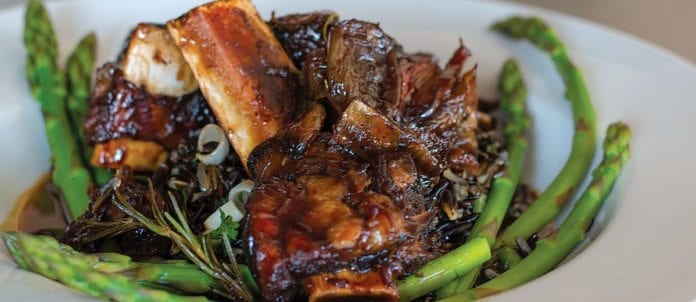It used to be enough for chefs to prepare a selection of the requisite “meat and two veg” on a plate and call it done. But those days are over,since restaurant-goers are now craving specific cuts or types of meat prepared in innovative ways and paired with creative sides. Across Canada, beef, pork and chicken remain the preferred proteins, continuing to shine on menus from Vancouver to Newfoundland. In fact, when combined, these three proteins account for nearly 3.4-billion servings at Canadian restaurants in the 12-months ending February 2014, according to Joel Gregoire, account manager, Foodservice at The NPD Group in Toronto.
Porcine Power
Pork is “the clear winner” in growth over the past year with a five-per-cent increase in servings, notes Gregoire. That stat rings true for Anthony Rose, chef and co-owner of Toronto’s Rose and Sons, Big Crow and Fat Pasha, who extols the virtues of pork. “When I was young, pork was the forbidden fruit,” he recalls. “When I found it, I loved it. You can use the whole thing, it’s easy to butcher and all of it is delicious.”
That’s why chefs, such as Rose, Alexander Svenne, chef and co-owner of Winnipeg Bistro 7 1/4 and Jesse Vergen, executive chef of Saint John, N.B.’s Saint John Ale House, buy entire pigs to butcher in-house. In fact, Vergen says his support of locally produced heritage breeds has contributed to the success of his pork and beef offerings. “I would say regional sourcing on the purchasing side is very strong in Canada, and bringing in a whole animal is very hot.” But chefs aren’t just butchering their own meat to cut costs, they’re keeping their cooks, who are “hungry” to learn, satisfied, says Vergen. At the Saint John Ale House, every possible pig (preferably Tamworth) part is used. The skin is used to make crispy pork rinds, or it’s used in a salami-like cotechino, and a half pig’s head becomes a shared entrée served on a platter with an assortment of sides, including cauliflower salad, beans, pork jus and sometimes pork sausage rounds ($60). The Tamworth is also Rose’s pig of choice at his barbecue haven, Big Crow, where Hawaiian ham steak is served with grilled pineapple and honey butter hot sauce ($24), highlighting the breed’s nutty, earthy flavour profile. At Bistro 7 1/4, it’s the rich, fatty Berkshire that resonates with Svenne’s diners. “We use heritage breeds from small, local farms in Manitoba. Berkshire and a Berkshire-Mulefoot cross are our favourites,” he says. “It’s the best pork ever: it’s juicier, has more flavour and has a nice, sweet fat.” Ten years ago, Svenne says pork was a harder sell, but using these heritage breeds and having a story behind where the meat comes from has fuelled diners’ enthusiasm for more flavourful meat. In fact, customers ask about the provenance of his pork. “They want to know, because supporting local is important. So we tell them about Clint and Pam Cavers of Harborside Farms, because they do it right and raise their animals in a mixed pasture, perfectly sustainable, humane farm,” says Svenne. The meat from the farm is used to make a pork-belly appetizer spiced and cured in cumin, coriander, turmeric and cinnamon sugar, served with escargots and coconut milk ($15). But, the fan favourite is a main dish — a 24-ounce maple-glazed Berkshire pork chop served with succotash and onion rings ($32).
On the other end of the foodservice spectrum, the quick-service restaurant pork servings share jumped to 64 per cent in 2014, up from 52 per cent in 2008, according to The NPD’s Gregoire. “As Canada’s QSR market becomes increasingly competitive, the need for innovation intensifies. Given how the share of pork has increased in the half decade, ‘the other white meat’ looks to be a part of this innovation strategy,” says Gregoire.
Johnny Prassoulis, owner and chef behind the Holy Chuck burger eatery in Vaughan, Ont. and Toronto, is a good example of someone using innovative thinking. His supplier sources Canadian, maple-smoked bacon that crowns a variety of offerings at Holy Chuck — from burgers, poutine and milkshakes to desserts. But it was Prassoulis’ experimentation with grinding bacon strips into patties that really put his exuberant burger creations on the map. For example, his Misunderstood Fat Pig consists of two all-bacon patties, triple cheese and crispy bacon adorned with a homemade bacon dressing ($12). And it’s a big seller.
Beef Brawn
While NPD research shows that the aforementioned pork’s popularity has skyrocketed in the 12-months ending in February 2014, beef servings grew by just under three per cent.
For his part, Svenne is trying to get consistent access to grass-fed beef, ideally specific breeds such as the Texas Longhorn or Herefords. “I’m building relationships with farmers to get more of this beef here in Manitoba, but it’s challenging. Part of the problem is that most of the cattle here is shipped to Alberta for processing, the other part [of the problem] has to do with the animals’ breeding seasons. It’s becoming increasingly expensive to overwinter them,” explains Svenne.
For now, that means most of the Winnipeg chef’s beef is certified Canadian Angus, which he prepares sous-vide. His short ribs slowly cook for 72 hours until they’re medium-rare and fall apart when served. “It’s bright red on the inside, and we glaze them with maple, soy, chili and ginger with a side of potato purée as an appetizer ($15).” For a main, he serves a daube of beef short rib with orange, red wine and rosemary on wild rice ($29).
At Big Crow in Toronto, Rose uses local fruit hardwoods, such as apricot or cherry, to smoke Angus beef ribs from Alberta low and slow. “I like to put something in and forget about it. It’s very simple — you set the temperature and go. Our ribs take two to three hours,” he says. The flavour is a hit with diners, who order the baby back ribs with pecorino, walnut, sage and pears (half slab $17, full slab $32) almost religiously. On the charcoal grill, there’s the one-pound barbecue flank steak with an ancho chili mezcal barbecue sauce and a side of guacamole for $26.
Rose says he’d love to get his hands on a steady supply of heritage breed beef, but, like Svenne, finds the consistency an issue.
Saint John Ale House has an impressive beef program, netting a cross of Scottish Highland and Belted Galloway cattle that forage on grass from New Brunswick farmer Larry Slipp. These cattle need an extra two years of growth to reach maturity. “That gives our beef a richer, more intense flavour,” says Vergen. The beef is then dry-aged on site to further enhance its flavour. And, it helps that Vergen can use any available beef cut when creating the restaurant’s classic steak frites. It’s simply grilled and topped with a herb butter and served with a side of tossed greens ($17.64).
Beef is the backbone of Holy Chuck’s business. Prassoulis sources 90-per-cent Ontario beef; the rest comes from other Canadian regions and is a mix between Angus, Limousine, Charolais and Hereford with no added hormones or antibiotics. He buys whole muscle cuts, not trim, and griddle smashes his salt-and-pepper adorned patties, searing them the way customers love.
Plucky Poultry
While pork, followed by beef, has risen in consumption, poultry has remained flat. However, it’s still the top protein ordered by Canadians with 1.2-billion servings at Canadian restaurants in the 12-months ending February 2014, reports NPD’s Gregoire.
Rose hypothesizes that the rise of protein-centric diets, such as the Paleo diet, have something to do with people’s increased carnivorous cravings, and white meat plays into that, too. “I love chicken; it’s my go-to when I’m out. We sell a ton of Cornish game hen — you can eat a whole hen and feel pretty good about yourself,” he says, alluding to its more healthful properties. At Fat Pasha, the little hens get dressed in a butter, pine nuts, burnt orange and harissa glaze, ($25) while the chicken at Rose and Sons is brined with sour pickle and buttermilk and marinated before being deep-fried. It’s served with a herb-and-cheddar biscuit, pimento cheese and dill cucumber ($26).
The lunch-only buttermilk fried chicken ($14.89) is so popular with Saint John Ale House diners that Vergen has almost daily requests to include it on the dinner menu. The fried chicken is made with Meat King chickens. “They’re a cross between a Cornish game hen and a White Rock chicken. They’re grass fed — supplemented with organic grains so they have a proven feed-to-meat conversion.” Generally speaking, Vergen sources his chicken from Harmony Growers Vegetables in Quispamsis, N.B. (he is a partner) and Jolly Farmer in Northampton, N.B., among others.
Svenne and Prassoulis are less enthusiastic about the birds. Holy Chuck doesn’t sell any chicken. “I’m not a fan of it myself. It’s bland, especially when I use it as a burger. I’d have to add spices and such to it to make it taste like anything,” says Prassoulis. Svenne adds, “Chicken offerings feature very little on my list. Maybe it’s because I’m not excited about what I can get.” Svenne says he only has access to conventionally farmed, mass-produced breeds, which lack flavour and texture. “I can show any customer a picture of the pigs, show them the farmer and talk about how he raises his animal — I know the process to the end. I’ve nothing to say about chicken.” But Svenne and Prassoulis both admit they might change their tune if more flavourful, free-range heritage breeds were available to them on a consistent basis.




















